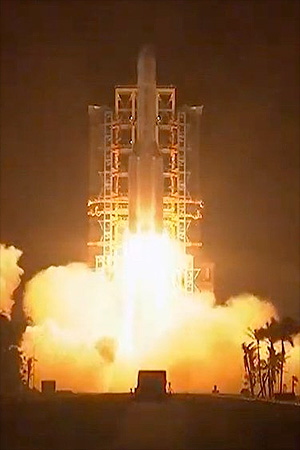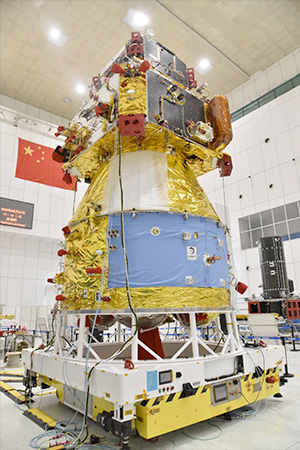November 23, 2020 — China has launched a spacecraft to the moon in an attempt to do something that has not been achieved in almost 45 years — return lunar samples to Earth.
The Chang'e 5 mission lifted off on a Long March 5 rocket from the Wenchang Satellite Launch Center on Hainan Island, located in the South China Sea, on Monday (Nov. 23) at 3:30 p.m. EST (2030 GMT or 4:30 a.m. local on Nov. 24).
The mission is targeting a moon landing in the Mons Rümker region of Oceanus Procellarum ("Ocean of Storms"), a previously unexplored area on the Earth-facing or near side. It is expected to operate for one lunar day (two weeks) on the surface, during which it will collect up to 4.4 pounds (2 kilograms) of lunar regolith — soil and small moon rocks — from a depth up to 6.5 feet (2 meters).
The Chang'e 5 spacecraft is comprised of a lander, an ascent vehicle, an orbiter and a reentry capsule. The four-legged lander is equipped with a coring drill and a robotic arm to collect the lunar samples, which will be placed into container on the ascent vehicle. The lander also has a panoramic camera, a regolith-penetrating radar and a mineralogical spectrometer.
Once the sampling activities on the moon's surface are complete, the ascender will lift off and dock with the service module in lunar orbit. The collected samples will then be transferred to the reentry capsule before the service module propels the spacecraft back towards Earth.
On approach to the planet, the capsule will separate from the service module to perform a high-speed atmospheric skip reentry. The capsule will then parachute to a touchdown in the Siziwang Banner in Inner Mongolia, near where the Shenzhou astronaut missions have landed, on or about Dec. 15.
Chang'e 5 — named after the moon goddess from Chinese mythology — is the sixth mission in the Chinese Lunar Exploration Program (CLEP), which the country established in 2003 to ultimately land Chinese astronauts on the moon. Prior to Chang'e 5, the CLEP missions included two orbital missions, two landers with rovers and a test mission (Chang'e 5-T1) that demonstrated the ability to return a spacecraft from lunar orbit.
When the Chang'e 5 lander touches down on the moon, it will mark the first time that China has had two active missions on the lunar surface. The Chang'e 4 mission, which achieved the first-ever landing on the far side of the moon in 2019, continues to operate in the Von Kármán crater on the South Pole-Aitken basin.
If Chang'e 5 is successful in collecting samples and returning them to Earth, it will mark the first such mission to do so since the former Soviet Union's Luna 24 mission, which retrieved 6 ounces (170.1 grams) of moon material in August 1976.
In total, there have been nine missions prior to Chang'e 5 that have returned moon rocks and lunar soil, including six Apollo missions launched by the United States and three Soviet Luna missions. The twelve NASA astronauts who walked on the moon brought back a total of 842 pounds (382 kg) of lunar samples between 1969 and 1972.
The Chang'e 5 samples are expected to be the youngest pieces of the moon to be returned for study. Mons Rümker is an isolated volcanic formation located in the northwest part of the moon, where the geological record dates to 1.21 billion years ago. By comparison, the Apollo astronauts gathered material that was dated to 3.1 to 4.4 billion years old.
"With Chang'e 5, China has launched an effort to join the U.S. and the former Soviet Union in obtaining lunar samples. We hope China shares its data with the global scientific community to enhance our understanding of the moon like our Apollo missions did and the Artemis program will," NASA said in a statement.
The European Space Agency (ESA) is supporting the Chang'e 5 mission by tracking the spacecraft as it departs and returns to Earth, as well as by providing an on-call back-up for China's ground stations.
The Chang'e 5 lunar samples will be stored at the Chinese Academy of Sciences' National Astronomical Observatory of China in Beijing, with a small cache to be held elsewhere as a precaution. China plans to put some of the samples on public display, but it is not yet clear if any of it will be sent outside of the country, whether for exhibit or for study. |
|

China's Long March 5 rocket topped with the Chang'e 5 spacecraft launches on the country's first attempt to collect and return samples from the surface of the moon, on Monday, Nov. 23, 2020. (CCTV)

China's Chang'e 5 spacecraft, from the top, lunar ascent vehicle, lunar lander, reentry capsule and service module, as seen being prepared for launch. (CNSA) |
